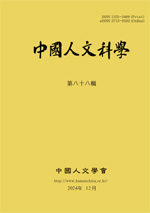본 연구는 기호학의 시각을 통해 문화 기호로서 문인들의 袒裸 이미지에 접근하여, 이미지의 시각적 표현 이면에 있는 심층적인 기호의 의미를 탐색하고자 한다. 퍼스(Charles Sanders Peirce)의 기호 삼원론(도상, 지표, 상징) 이론 구조를 활용하여 문인들의 袒裸 이미지의 기호의 역할을 분석하고 기호가 가지고 있는 다양한 문화적 이념의 상징적 표현을 밝히는데 목적을 두고 있다. 《高逸图》와 《荷亭消夏图》의 두 작품을 통해 문인들의 袒裸 이미지를 역사적 언어 환경에서 해석하여 袒裸 이미지 속 기호 구조와 문화적 언어 환경에서 단계적으로 분석하여 문화적 이념의 상징적 표현을 밝히고자 하였다. 문인들의 袒裸 이미지는 문인들의 상태를 재현한 시각적 유사성을 통해 자유로움과 소탈함을 표현하고 있으며, 문인의 袒露 형태와 자세, 그리고 자연 속의 山间小径, 溪流旁, 林间空地 등에 의탁하여 문인 은사들의 세속의 속박에서 벗어나 내면의 순수함으로 돌아가려는 정신적 욕구를 지표하고 있다. 또한, 문인들의 袒裸 이미지는 “外在的袒裸”를 초월한 “精神式袒裸” 상징하여 정신적 독립과 도덕적 자유 등 문인들의 자기 표현에 대한 지속적인 추구 의미를 전달하고 있다. 본 연구는 문인들의 袒裸 이미지에 대한 이해를 심화시켰을 뿐만 아니라 예술사와 문화 기호 연구에 새로운 방법론을 제공하여 중국 고대 예술에서 기호와 문화의 보다 다양한 상호작용 관계를 드러내고자 하였다.
The portrayal of nude scholars occupies a distinctive position within the annals of Chinese art history, functioning not only as a representation of the scholars' quotidian lifestyles but also as a manifestation of their spiritual aspirations and philosophical doctrines. Nonetheless, extant scholarship has predominantly emphasized the surface-level visual representations, thereby neglecting an in-depth exploration of the underlying symbolic significances inherent in this imagery. This study employs a semiotic framework to elucidate the intricacies of the nude scholar motif as a cultural signifier and its emblematic functions within historical contexts. The primary objective is to dissect the symbolic roles of nude scholars across multiple dimensions utilizing Charles Sanders Peirce’s triadic sign theory—comprising icons, indexes, and symbols—to unveil the cultural ideologies encapsulated within these representations. Methodologically, this research integrates semiotic theory with empirical analyses of selected cases from ancient Chinese paintings, facilitating a stratified examination of the sign structures associated with nude scholars and their interpretative meanings within their cultural milieus. The findings indicate that the depiction of nude scholars, through iconography, mirrors the authentic states of scholarly existence, thereby embodying notions of liberty and nonconformity; as indexes, their integration with natural landscapes signifies the profound interrelationship between scholars and the natural world, advocating a lifestyle liberated from mundane constraints; and as symbols, the nude scholar transcends mere physical depiction to encapsulate the intellectual and emotional ethos of the scholars. The significance of this study lies in its contribution to the expansion of the symbolic paradigms within ancient Chinese painting through a semiotic lens, offering novel perspectives for traditional art historical research. Furthermore, the semiotic methodology not only enriches the comprehension of the nude scholar archetype but also furnishes a robust methodological framework for the interdisciplinary study of art history and cultural symbolism, thereby illuminating the complex interplay between symbols and cultural narratives in ancient Chinese art.
Ⅰ. 绪论
Ⅱ. 皮尔斯符号三分法及其与文人袒裸形象耦合研究的可行性
Ⅲ. 基于符号三分法的绘画中文人袒裸形象分析
Ⅳ. 结语
(0)
(0)
